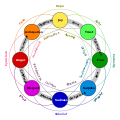Amygdala hijack

An amygdala hijack refers to an immediate and overwhelming emotional response that is disproportionate to the actual stimulus because it has triggered a more significant perceived threat.
Definition
The output of sense organs is first received by the thalamus. Part of the thalamus' stimuli goes directly to the amygdala or "emotional/irrational brain", while other parts are sent to the neocortex or "thinking/rational brain". If the amygdala perceives a match to the stimulus, i.e., if the record of experiences in the hippocampus tells the amygdala that it is a fight, flight or freeze situation, then the amygdala triggers the HPA (hypothalamic–pituitary–adrenal) axis and "hijacks" or overtakes rational brain function.[5]
This emotional brain activity processes information milliseconds earlier than the rational brain, so in case of a match, the amygdala acts before any possible direction from the neocortex can be received. If, however, the amygdala does not find any match to the stimulus received with its recorded threatening situations, then it acts according to the directions received from the neocortex. When the amygdala perceives a threat, it can lead that person to react irrationally and destructively.[6]
Goleman states that emotions "make us pay attention right now—this is urgent—and gives us an immediate action plan without having to think twice. The emotional component evolved very early: Do I eat it, or does it eat me?" The emotional response "can take over the rest of the brain in a millisecond if threatened".[7]
Goleman later emphasized that "self-control is crucial ... when facing someone who is in the throes of an amygdala hijack"
Non-distressing hijack
Goleman points out that "not all limbic hijackings are distressing. When a joke strikes someone as so uproarious that their laughter is almost explosive, that, too, is a limbic response. It is at work also in moments of intense joy."[11]
He also cites the case of a man strolling by a canal when he saw a girl staring petrified at the water. "[B]efore he knew quite why, he had jumped into the water—in his coat and tie. Only once he was in the water did he realize that the girl was staring in shock at a toddler who had fallen in—whom he was able to rescue."[12]
Emotional relearning
Joseph E. LeDoux was positive about the possibility of learning to control the amygdala's hair-trigger role in emotional outbursts. "Once your emotional system learns something, it seems you never let it go. What therapy does is teach you how to control it—it teaches your neocortex how to inhibit your amygdala. The propensity to act is suppressed, while your basic emotion about it remains in a subdued form."[13]
See also
References
- ^ "Conflict and Your Brain aka The Amygdala Hijacking" (PDF). Retrieved 2010-04-06.
- ^ Nadler, Relly. "What Was I Thinking? Handling the Hijack" (PDF). Retrieved 2019-04-15.
- PMID 7872730.
- S2CID 17284478.
- ^ Bedard, Moe (2021-10-31). "Battle for the Noosphere: How the human mind can be highjacked via the amygdla". Gnostic Warrior. Retrieved 2022-09-15.
- ^ Freedman, Joshua. "Hijacking of the Amygdala" (PDF). Archived from the original (PDF) on November 22, 2009. Retrieved 2010-04-06.
- ^ Hughes, Dennis. "Interview with Daniel Goleman". Retrieved 2010-04-06.
- ^ Daniel Goleman, Working with Emotional Intelligence (1999) p. 87
- ^ Goleman, Emotional Intelligence p. 144
- ^ Rita DeMaria et al., Building Intimate Relationships (2003) p. 57
- ^ Goleman, Emotional Intelligence p. 14
- ^ Goleman, Emotional Intelligence p. 17
- ^ Goleman, Daniel (August 15, 1989). "Brain's Design Emerges As a Key to Emotions". The New York Times.


